Automatic Room Lighting System is a microcontroller based project that automatically turn on or off the lights in a room. Electricity, being one of the most important resources, must be utilized carefully.
We often forget to switch off lights or fans when we leave a room. By using this system, we can intentionally forget about the lights as the system will automatically take care of them.
The digital World we are living in allows us to use different technologies to automatically perform certain tasks. Such automation is very useful in certain areas like energy consumption, reducing human efforts, improving standard of living etc.
Outline
ToggleAutomatic Room Lighting System using Microcontroller
The project implemented here is one such project where the microcontroller based system automatically controls the room lights.
The aim of this project is to automatically turn on or off the lights in a room by detecting the human movement. We implemented this project using 8051 Microcontroller and two Infrared (IR) sensors.
Since the job of the circuit is to turn on the light when someone enters the room and turn off the light when the last person leaves the room, the project has to internally count the number of visitors entering and leaving the room. Hence, the project acts as an Automatic Room Lighting System as well as Bidirectional Visitor Counter.
Warning: A 230V light bulb is used in this project and is connected to relay and mains supply. You should be very careful when connecting the mains wires.

Components Required
- AT89C51 Microcontroller (any 8051 architecture based microcontroller)
- 8051 Development Board
- 2 x Infrared Sensors
- 16 x 2 LCD Display
- 5V Relay Module
- Lamp
- Connecting Wires
- Power Supply
Circuit Description
Let us see the design of the circuit for automatic room lighting project. The circuit diagram shows all the connections with respect to microcontroller. If you are doing this project on a development board, some of the connections mentioned in the circuit diagram might not be necessary.
Also, we have used modules for Relay and IR Sensor and hence, the connections are shown with respect to those modules only. Corresponding circuit diagrams are also provided.
Coming to the circuit design, a 16 x 2 LCD Display, two IR Sensors and a 5V Relay Module must be connected to the 8051 Microcontroller. First, connect the 8 data pins of the LCD to PORT1 pins i.e. P1.0 to P1.7.
The 3 control pins of LCD i.e. RS, RW and E are connected to P3.6, GND and P3.7 pins respectively. A 10 KΩ Potentiometer is connected to contrast adjust pin of LCD i.e. its pin 3.
Two Reflective type IR Sensors are connected to PORT2 pins i.e. P2.0 and P2.1. Detailed circuit of the IR Sensor is mentioned in the Component Description.
The input of the 5V Relay is connected to PORT0 pin P0.0. The detailed circuit of the 5V Relay module used in the project is explained in the component description section. Alternatively, you can construct the circuit as per the circuit diagram (which consists of 5V Relay, Transistor, Diode and a Resistor).
Component Description
IR Sensor Module
An Infrared or IR Sensor is a simple circuit that is used to detect objects (Proximity Sensor) or measure distance (Range Finder). An IR Sensor consists of 3 components: an IR Transmitter (IR LED), an IR Receiver (like a Photo Diode) and a signal processing circuit.
We have used reflective type IR sensor modules in this project. The detailed circuit diagram of the module is shown in the following image.

5V Relay Module
A 5V Relay Module is used in this project which helps 8051 Microcontroller to operate high voltage AC loads like a light. The detailed circuit of the Relay Module is shown in the following image. It consists of a 5V Electromechanical Relay, an Optocoupler IC, transistor, two resistors and two diodes.
 Working of the project
Working of the project
In this project, an automatic room lighting system is developed using 8051 microcontroller. The working of the project is explained here.
The main component of the project is IR Sensor and we have used two of them. The placement of the sensors is important as it will determine the functioning of the project.
Practically speaking, both the sensors must be placed on the either side of the door or entrance of the room. The sensor placed on the outside of the room is named as Sensor 1 and the sensor, which is placed on the inside is named Sensor 2.
When a person tries to enter the room, Sensor 1 detects the person first and then Sensor 2. This action will indicate the 8051 Microcontroller that the person is entering the room.
Hence, the microcontroller will turn on the light and also increments the visitor counter to 1. If there are more visitor, the microcontroller will keep the light turned on and increments the visitor counter accordingly.
When a person tries to leave the room, Sensor 2 detects the person first and then Sensor 1. This process will make the microcontroller to understand that a person is trying to leave the room and hence, it will decrement the count of visitors. The microcontroller will not turn off the light until the last person has left the room.
As the visitors start leaving the room, the visitor count will be decremented and when the last person leaves the room, the count be comes 0. During this point, the microcontroller understands that there is nobody in the room and turns OFF the light.
Caution: Be extremely cautious when using 230V mains supply.
Code
Applications
- Automatic Room Lighting with Bidirectional Visitor Counter can be used to automatically turn on the light in a room when a person enters the room and turn it off when the person leaves the room.
- The project can also be dubbed as a Bidirectional Visitor Counter it is an integral part of the Automatic Room Lighting circuit.
- The project can be modified with LEDs and as the number of persons in the room increases, the number of LEDs turning ON also increases.

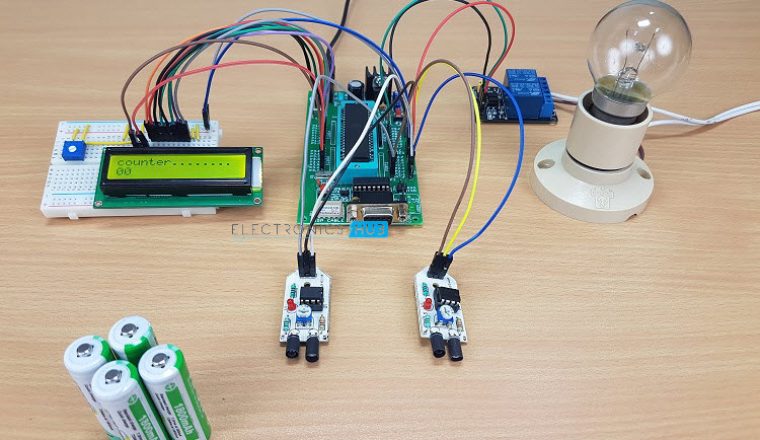
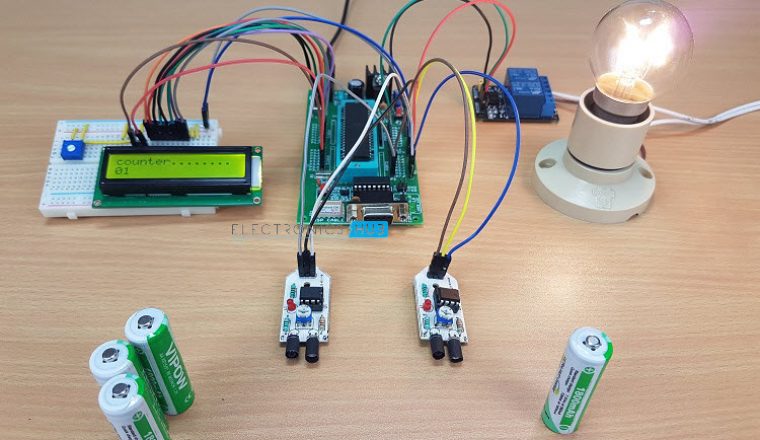
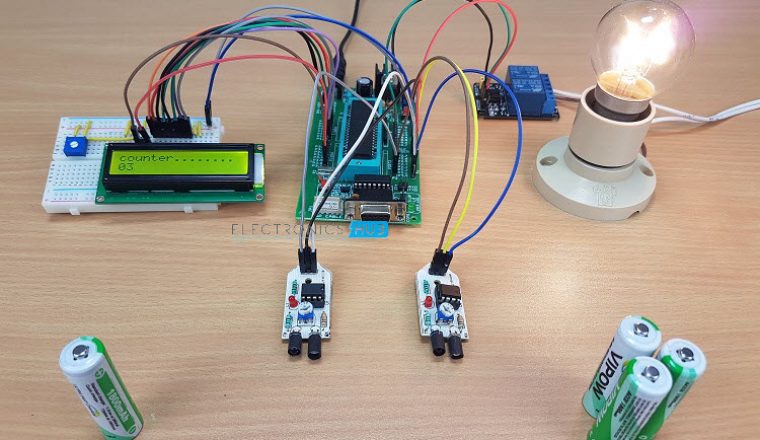
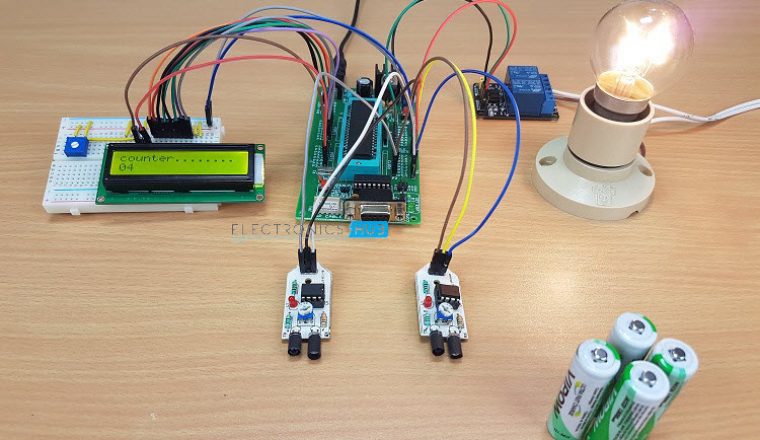
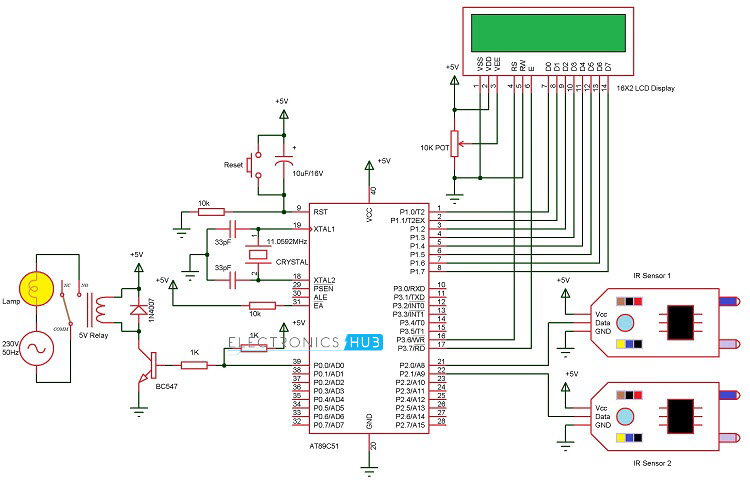
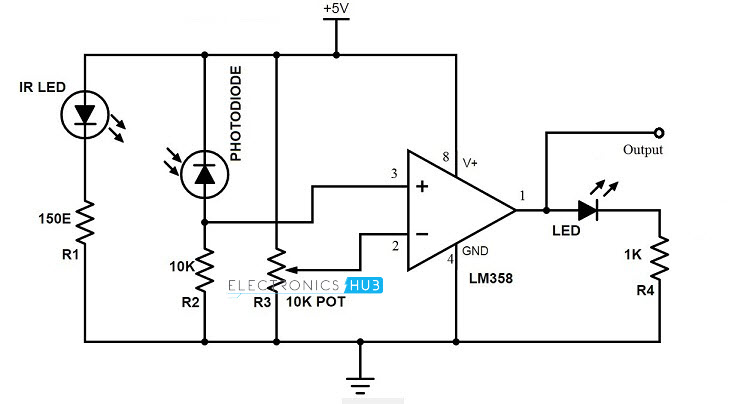
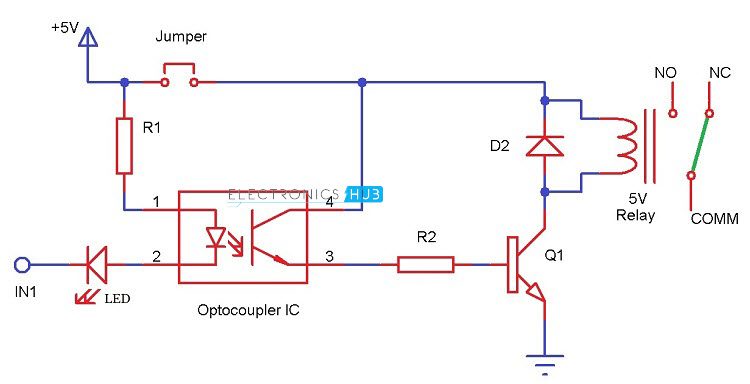

42 Responses
Very good circuit for me. I want this Micro ic is also used for automatic water level controlER. Please give me the circuit details.
Thanks
Sir why you use Microsoft 8051microsoft board
Why can’t you use 8052 microcontroller.and if we don’t need to light in the morning time than we can switch off the light manually so where we can fix the switch
This project was tested?
Yes. Output video will be updated soon..
When will you upload the output Vedio. And this circuit is tested or not
Hi, The project and the code are tested and we will upload the video very soon.
Thank you for this circuit
but how can i install this to my room ????
how should i arrange the sensors ??(on either side of the room door??)
what software should i use to dump the given code
can this control multiple devices like a fan and light at a time ???
what is the maximum sensing distance of these IR sensors??
Hope you help me with the details
Hi, You can install the sensors on either side of the wall where the door opens (not on the door). We have used the software bundled with the programmer we are using. So, the software used for dumping the code depends on the programmer hardware (burner). Yes. It can control multiple devices. You need a multi-channel relay board for that. The maximum distance between the individual sensors can be pretty large depending on the wiring (Do not go for more than 30CM)
Can u pls tell me hw can i upload the codes to the ic
Hi. Can I make this circuit in engineering project? Is it in working mode?
Provide the complete components requirements in hardware with each and every component values and software tools
Can u give me the complete decription of components used such as those used for lcd display .i m not getting the idea from video what are those???
16×2 lcd display
Can these codes be used in other microcontroller like Atmega328p or any other IC
I tried doing this but somehow it doesn’t work. The count only goes up and never down no matter where you swipe. Please help.
What is the model of the IR sensor being used? Is there any replacement that we could use for the same.
Is it a complete project code? bcoz I am testing on Proteus 7 professional simulator and it not running.
Hi
Iam getting trouble in dumping the program in the circuit please guide me.
have u dumped the code successfully? i am facing an issue
Iam using USBSP as connector to circuit and the laptop.
And PROGISP as the programmer. While dumping the program it is displaying chip enble error.
i am using at89s52 development board.it works or not..?
Mmmm very interesting. Please help me to build this as my project
Circuit Diagram, Components and Code is already provided.
In which software can i build this code given above.
Keil µVision.
Yes. I Think. Try Amazon.
Coding is unable to run
What to do ?
Can u send me the value of optocopler ic
It is 817C. It is a part of the Relay Board we have used.
Yes.
Is the IR sensor used PIR or sound based?
In these project when I’m using ir sensors that time it will not work correctly but ir sensors reaplce in switch that time it will correctly work why
Why you chose this design?
what is the purpose of using this 8051 board ? Can we use an aurdino board instead ?
What is the purpose of the 8051 board ? Can we use an aurdino board instead ?
What is the purpose of 8051 development board ? Can we use an aurdino board ?
can you sell me this project when it’s completely done and working coz I have tried severally but it didn’t work
Sir, can you please tell me how i cam burn code in the microcontroller.
How supply is given to the development board
Through batteries
Or adaptor
is it ok, that MCU can run ACU and lights?
can I replace 8051 Development Board with STM32 Nucleo-64 arduino board?
How can I dump the code in microcontroller??